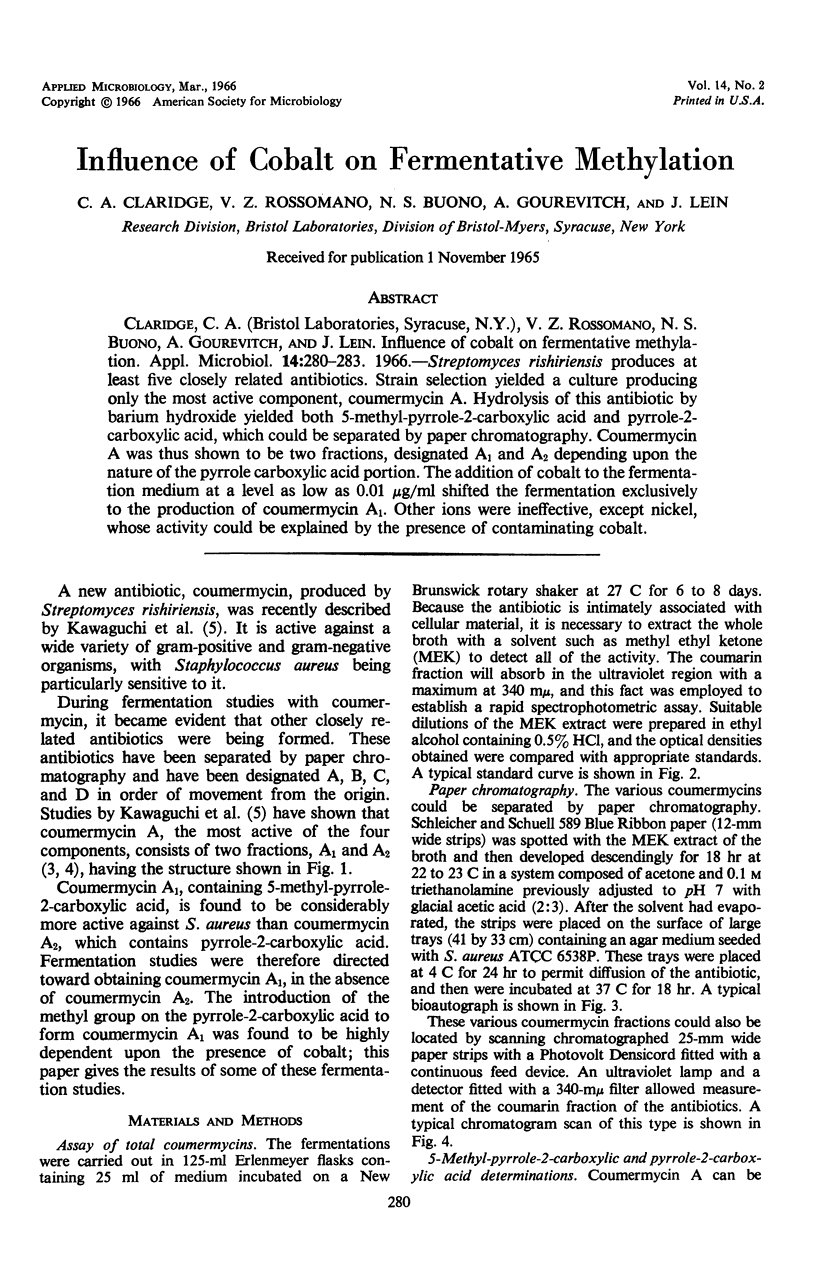Abstract
Streptomyces rishiriensis produces at least five closely related antibiotics. Strain selection yielded a culture producing only the most active component, coumermycin A. Hydrolysis of this antibiotic by barium hydroxide yielded both 5-methyl-pyrrole-2-carboxylic acid and pyrrole-2-carboxylic acid, which could be separated by paper chromatography. Coumermycin A was thus shown to be two fractions, designated A1 and A2 depending upon the nature of the pyrrole carboxylic acid portion. The addition of cobalt to the fermentation medium at a level as low as 0.01 μg/ml shifted the fermentation exclusively to the production of coumermycin A1. Other ions were ineffective, except nickel, whose activity could be explained by the presence of contaminating cobalt.
Full text
PDF



Selected References
These references are in PubMed. This may not be the complete list of references from this article.
- GUEST J. R., FRIEDMAN S., WOODS D. D., SMITH E. L. A methyl analogue of cobamide coenzyme in relation to methionine synthesis by bacteria. Nature. 1962 Jul 28;195:340–342. doi: 10.1038/195340a0. [DOI] [PubMed] [Google Scholar]
- KAWAGUCHI H., NAITO T., TSUKIURA H. STUDIES ON COUMERMYCIN. A NEW ANTIBIOTIC. II. STRUCTURE OF COUMERMYCIN A1. J Antibiot (Tokyo) 1965 Jan;18:11–25. [PubMed] [Google Scholar]
- KAWAGUCHI H., TSUKIURA H., OKANISHI M., MIYAKI T., OHMORI T., FUJISAWA K., KOSHIYAMA H. STUDIES ON COUMERMYCIN, A NEW ANTIBIOTIC. I. PRODUCTION, ISOLATION AND CHARACTERIZATION OF COUMERMYCIN A1. J Antibiot (Tokyo) 1965 Jan;18:1–10. [PubMed] [Google Scholar]
- Kawaguchi H., Miyaki T., Tsukiura H. Studies on coumermycin, a new antibiotic. 3. Structure of coumermycin A2. J Antibiot (Tokyo) 1965 Sep;18(5):220–222. [PubMed] [Google Scholar]
- MEYERHOF O., SHATAS R., KAPLAN A. Heat of hydrolysis of trimetaphosphate. Biochim Biophys Acta. 1953 Sep-Oct;12(1-2):121–127. doi: 10.1016/0006-3002(53)90130-9. [DOI] [PubMed] [Google Scholar]
- MOUNTER L. A., BAXTER R. F., CHANUTIN A. Dialkylfluorophosphatases of microorganisms. J Biol Chem. 1955 Aug;215(2):699–704. [PubMed] [Google Scholar]
- NICHOLAS D. J., FISHER D. J., REDMOND W. J., OSBORNE M. A COBALT REQUIREMENT FOR NITROGEN FIXATION, HYDROGENASE, NITRITE AND HYDROXYLAMINE REDUCTASES IN CLOSTRIDIUM PASTEURIANUM. Nature. 1964 Feb 22;201:793–795. doi: 10.1038/201793a0. [DOI] [PubMed] [Google Scholar]
- RUTTER W. J., LARDY H. A. Purification and properties of pigeon liver malic enzyme. J Biol Chem. 1958 Aug;233(2):374–382. [PubMed] [Google Scholar]
- Rickes E. L., Brink N. G., Koniuszy F. R., Wood T. R., Folkers K. Vitamin B12, A Cobalt Complex. Science. 1948 Aug 6;108(2797):134–134. doi: 10.1126/science.108.2797.134. [DOI] [PubMed] [Google Scholar]
- VOGEL H. J., BONNER D. M. Acetylornithinase of Escherichia coli: partial purification and some properties. J Biol Chem. 1956 Jan;218(1):97–106. [PubMed] [Google Scholar]


